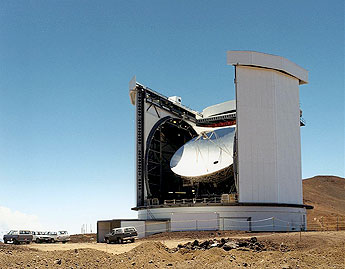Precision
Laser Cutting for Telescopes

Mike MacIntosh of the UK Astronomy technology
centre stated “This project puts ATC
at the forefront of submillimetre technology.
It has also encouraged us to consider setting
up a foundation for UK experts to carry out
further investigations in superconducting
detector arrays. The later cutting techniques
that we and Heriot-Watt have developed will
not only be applicable to astronomy, but will
have wider impact in the semiconductor industry.”
|
The UK Astronomy Technology Centre (ATC) Edinburgh
is the national centre for astronomical technology,
designing and building instruments for many of the
world’s major telescopes. It also project
manages UK and international collaborations, where
scientists carry out observational and theoretical
research into fundamental questions such as the
origins of planets and of galaxies. It recently
called on the expertise of Heriot-Watt University,
via colleagues at the Scottish Microelectronics
Centre (SMC), to help it maintain its position at
the forefront of sub millimetre astronomy technology.
Over the past decade the UK has established itself
as a world leader in sub millimetre astronomy. It
is the detecting of very cold materials which allows
the understanding of the origins of the most mysterious
earliest evolutionary stages of galaxies, stars
and planets.
Astronomers in the UK have had access to some of
the best telescope facilities and the most advanced
instrumentation in the world. In particular, the
SCUBA-2 bolometer camera, a state of the art wide-field
camera that gives unprecedented sensitivity and
imaging power. SCUBA-2, in conjunction with the
James Clerk Maxwell Telescope has completely revolutionised
this area of astronomy. Using sub millimetre wave
astronomy and observations, astronomers can examine
molecular clouds and dark cloud cores with a goal
of clarifying the process of star formation from
earliest collapse to stellar birth.
A key component of the instrument is the detector
array, which is fabricated on hybridised silicon
wafers. These arrays require parts of the silicon
wafer to be deep-etched leaving “bridges”
of thickness of only 0.5 microns. Following this,
it is necessary to precisely dice the wafer, without
damaging these thin silicon nitride bridges, which
are very sensitive to mechanical shock. Other parts
of the device are very temperature sensitive and
require extremely high cleanliness.
The solution was to develop a suitable low-debris
laser-machining process, with minimal thermal and
mechanical shock. Prof Duncan Hand and his team
of researchers at the James Watt Institute for High
Value Manufacturing were able to exploit this process
and fabricate the material in the clean environment
which is required to enable ultra precision laser
cutting of wafers.
The results of this project will keep the UK and
the other project partners at the forefront of sub
millimetre astronomy technology.
For more information contact:
Duncan Hand
d.p.hand@hw.ac.uk
+44 0 131 451 3020
Also visit www.aop.hw.ac.uk |